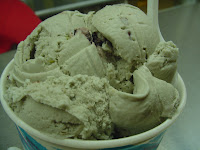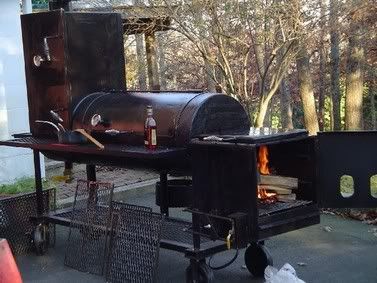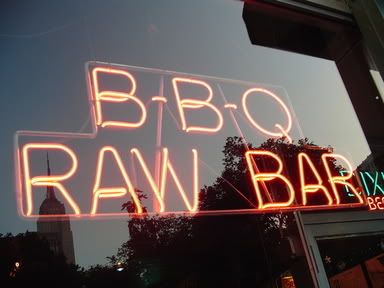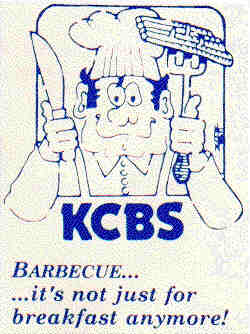Hope you all had a great weekend. We cooked up a storm and hopefully I'll have the pictures up tonight.
In the meantime, I wanted to share with you this article that ran in this weekend's Wall Street Journal. The article by Raymond Sokolov entitled "The Best Barbecue" is an excellent overview of the regional styles of barbecue and the places to find the good stuff. Sokolov has obviously done his homework and he names my good friend and awesome pitmaster,
Robbie Richter's Hill Country NY (note: Marc Glosserman is the owner of Hill Country and Elizabeth Karmel is listed as Executive Chef-- she came up with the sides and desserts). as one of the best in the country. I have to agree. For more information on the great places mentioned in the article, check out the interactive map when you're done.
 Photo courtesy of Austin 360
Photo courtesy of Austin 360
The Best Barbeque
Juicy brisket pulled straight from the pit in Texas. Pulled pork shoulder with crispy browned bits in Tennessee. And versions rivaling both in Boston and New York. Our food critic goes cross-country for the pick of the pits.
By RAYMOND SOKOLOV
June 30, 2007; Page P1
True barbecue is a complex, slow method of cooking meat in an enclosed space with low, indirect heat and smoke. True barbecue emerges from the "pit" still moist and very tender after as many as 18 hours of cooking. Its flavor is a mix of the smoke, the sublimation of fat, the caramelization of meat juices, spices rubbed on it, soaked or injected into it and sauce basted ("mopped") over it while it cooks.
Within all this, there are endless variations: Tennessee takes its pulled pork from the shoulder; eastern North Carolina uses the whole hog, and flavors the smoky, succulent meat with vinegar sauce; and of course Texas serves up beef from ribs to brisket to sausage. But as I learned on an odyssey in search of America's best barbecue, the cuisine is outgrowing its regional origins. Barbecue joints up north can hold their own against the best below the Mason-Dixon.
The steamrolling migration of true Q is obviously a good thing for diners. But it's also a radical change for a cuisine that's always been defined by its regional differences -- two barbecue restaurants 100 miles apart in the South are likely to serve completely different styles, sauces and cuts of meat. The best northern barbecue restaurants take an anthropologist's approach: They scrupulously research the authentic methods for Carolina pulled pork and Texas brisket, but then offer them on the same menu.
The sleeker, sophisticated places up north may lack the romance of a trip to a shack in rural Alabama or Tennessee, but they also don't threaten the originals, a remarkable number of which show few signs of losing spirit or changing their methods. At Carl's Perfect Pig Bar B Que in White Bluff, Tenn., I dined on an artful jumble of shoulder shreds punctuated with browned bits of the outside of the meat. At Kreuz in Lockhart, Texas, I devoured juicy beef brisket, pulled from the smoker and sliced before my eyes.
In every region, the mutual differences may inspire fierce loyalty, but a fundamental essence and fundamental standards link all the multifarious versions of what is at bottom one place's version of the same brilliant idea.
 Photo of Robbie Richter by Josh Ozersky
Photo of Robbie Richter by Josh Ozersky
First, a word on what barbecue is not. Barbecue (the noun) is not something that occurs over direct flame in the open air. Grilling steaks or chicken or burgers is basically harmless, but it doesn't produce true barbecue in the strict sense applied on its native ground to this quintessentially American, smokily superb form of meat cookery. So those of us who will be barbecuing (the verb) on our grills on July 4 will not be eating barbecue 20 minutes later.
All barbecue ought to taste of the smoke given off by the fire it has cooked in, and should be juicy despite the long hours of exposure to heat. Pork ribs should not "whitebone": If you pull two ribs apart with your hands, meat should remain on both bones and no bone should show. Otherwise they are overdone.
Maybe the most important sign of seriously smoked barbecue is that curious pink line that the process leaves behind at the edge of the meat. You can easily taste the wood smoke in righteous 'cue. In my first bite of brisket at Smitty's Meat Market, a short drive from Kreuz in Lockhart, Texas, that smokiness was so strong, it changed my idea forever of what barbecue could be. This style of heavily smoked beef may take some getting used to but for me it is the zenith of the Q universe.
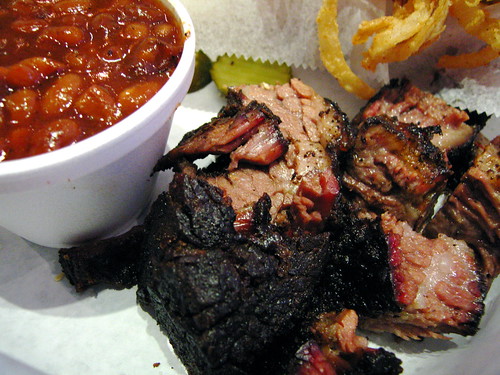 Photo of burnt ends at RUB BBQ by Slice from Flickr
Photo of burnt ends at RUB BBQ by Slice from Flickr
That doesn't mean I don't love the pork barbecue that other regions excel in. But Smitty's is a temple of purity, a dark brick cave of making, with its stark black steel-doored smokers and taciturn pitmen who stand in the heat of the post oak logs, pull out a piece of brisket and ask you if you want it sliced from the lean or the fatty end. I go for the fatty end -- more juice -- and don't mind that Smitty's is really just a specialized meat market. For sauce and cutlery, you go through a door from the darkness of the pit area to a bright-lit concession. The transition is something like the shock Plato tells us his cave-dwellers experienced when they emerged into the sun.
Purists in Lockhart eat with their hands and don't mess with sauce. I'm on their side when it comes to sauce, but if you can't do without it, you can't go wrong in a world where top-flight places serve anonymous brews ranging from sweetened ketchup to peppy vinegar, and anything in between.
A book could be written about the cole slaws -- shredded, chopped, hot, mild, vinegar-based or mayoed -- that Q joints offer along with tangy baked beans and a half-dozen other standbys. We particularly loved firecracker corn, a highly spiced corn on the cob. The classic dessert beyond all others is a vanilla pudding full of banana slices and vanilla wafers.
These dishes attached themselves to barbecue late in its history, which began before Columbus landed. Arawak Indians in the Caribbean must have been slow-cooking meat on a wood platform because their word for this grill moved into Spanish as barbacoa.
For them, as for early settlers, smoking meat was a simple and, it turned out, delicious way to preserve it. We owe our country hams and smoked bacon to this principle. And in poor rural communities in the south, white and black men adapted this into a style of preparing humble meats, first in open pits in the ground and later in the enclosed metal "pits" or smokers of today.
The most fervid celebration of this cuisine occurs every year at the barbecue contests held in hundreds of locations. Teams of mostly amateur chefs compete against each other for blue ribbons in categories such as whole hog or rub. So it seemed reasonable to start my quest at the country's premiere competition, a huge festival on the banks of the Mississippi called Memphis in May.
The odd thing about Memphis in May is that you can't eat the barbecue. The overwhelmingly male teams hang about in their colorful booths, minding their techno-pits. The general public just mills around or pays to go into a special tent where they can ingest limited samples of the contestants' output.
This elitist setup mirrors the larger barbecue world, which is starkly divided between the mob and the cognoscenti -- a paradoxically snobbish rift in a subculture built on a myth of rural simplicity and y'all-come populism. Barbecuemania is split between the uninstructed millions (who will eat a sparerib no matter where it's been) and the adepts who love to split bristles over where to find the best "dry" ribs or the tangiest vinegar-based sauce.
At Memphis in May, I cadged enough meat to conclude that there was plenty of bad 'cue and some very fine stuff to be had. But for those of us outside the contest circuit, the real contest is in restaurants, where pitmasters test their skills every day for the benefit of Everydiner.
The most famous barbecue venues tend to be big, souvenir-sauce-selling places coasting on their owners' fame as contest winners or on raves from the small coterie of barbecue critics. I trekked to Decatur. Ala., to Big Bob Gibson Bar-B-Q, a multiple first-place winner at Memphis in May, and found the pulled pork mushy and the much-touted sauce underwhelming. I had a passable lunch at Mike Mills's 17th Street Bar & Grill in the cheerless southern Illinois burg of Murphysboro. Mr. Mills uses applewood in his smokers, which is too mild for my Lockhartian taste for post oak.
The most famous of all barbecue restaurants is Arthur Bryant's in Kansas City, Mo. Put on the map by Calvin Trillin who in the 1970s called it "the single best restaurant in the world" in Playboy, Bryant's is now a minichain in Kansas City. I found the barbecue serviceable but unexciting.
Tennessee may qualify as the capital of the most basic kind of barbecue, pork shoulder "pulled" or shredded by hand. Shoulder, like other barbecue cuts, is not a luxury meat -- it's tough -- but benefits from the slow braising of the pit.
At Bozo's BBQ in Mason, east of Memphis, you don't need to sauce up the perfect squills of pork shoulder. Outside this unassuming family operation, a lonely whistling freight train rumbles by. The bright lights of the high-security federal pen next door cast an ominous shadow on the humble former farmhouse. Within, all is good cheer restrained by the confident reserve that comes from knowing you can pull pork so that each strand comes away long and perfect, like hanks of moist beige yarn.
This is the Memphis style at its apogee, 40 miles out from Graceland, and all the other sights and sounds of downtown. Bozo's does not serve ribs. Don't ask for brisket either. In this shrine of the shoulder of the sow, aficionados know that "barbecue" signifies only one cut of meat, from high on the hog.
For a serious challenge to this fare, you'd have to head to the Raleigh-Durham airport and scoot down to Wilber's in Goldsboro, N.C. You are now in whole-hog territory. Vinegar is the basic condiment underlying the pulled pork, which Wilber's variegates with meat fragments from all up and down the succulent swine. You could have this as a sandwich topped with chopped, vinegary cole slaw, but I prefer the unadorned piggy perfection. The southern-fried gizzards are also A-one and offer a crunchy counterpoint to the silken, mildly peppery main event. At Dillard's Bar-B-Que in the city of Durham, they offer a similar, if smokier pork in a dandy coleslaw sandwich.
Texas is another state with a high Q factor. In particular, I mean the woodsy hill country surrounding Austin, the state's capital of politics and intellect. Beef is the main meat here, beef ribs and brisket and piquant sausages that mix local German and Mexican ideas. Lockhart is the Vatican of this persuasion, with its rehabbed turn-of-the 20th-century downtown. This was where we found Smitty's, in a former Shiner's brewery, and Kreuz, pronounced "Krites" and referred to locally as the Church of Kreuz.
From there, we drove north to Oklahoma. Leo's in Oklahoma City and Oklahoma Style Bar-B-Q and Wilson's in Tulsa all offer hickory-smoked sliced brisket of very high quality. They also serve a regional specialty, bar-b-q bologna, segments of lunchmeat sausage smoked as if it were brisket or ribs, and a side dish of pickled mixed vegetables.
Then we headed home, literally and figuratively, to the three cities we have the closest ties to. In each of them, the menu represented, with great fidelity, barbecue styles originating elsewhere. Slows (no apostrophe please) in Detroit, where I was born, is a treasure-house of Q eclecticism. Its ribs were about as good as any we encountered anywhere.
The East Coast Grill in Cambridge, Mass., is rightly famous for its scholarly re-creation of pit barbecue, although we think even the first-rate eastern North Carolina pulled pork relies too much on its excellent vinegary sauce (probably because the kitchen thinks its customers wouldn't appreciate the meat on its own). And in New York City, the Cue millennium came to town last month in the form of Hill Country, a very skillful rendition of Texas barbecue based directly on Kreuz Market in Lockhart. Barbecue expert Elizabeth Karmel consulted on the operation, which imports its sausages directly from Kreuz and burns post oak in its three smokers.
The Q evangelists behind this barn of a place should think about extending their mission to the barbecue wilderness of Los Angeles. We ate in the local standbys Woody's and Phillips, but found their meats overcooked and undersmoked. What Tinseltown most needs these days is authentic Lockhart brisket followed by a rough-and-tumble banana pudding from Carl's Perfect Pig.
While we stuffed ourselves this spring with these splendid viands, and wiped our hands with pieces of paper toweling torn from vertical rolls standing within convenient reach, we kept trying to decide which restaurant would be our pick for champ of the pit-barbecue nation. In the end, because of the dramatic variation of style and content from place to place, we began thinking that any of the places we've mentioned favorably so far was tied for first with the rest.
But if I could only have one meal before being forced to turn vegan, I would charter a plane to Smitty's for a piece of brisket pulled from the pit.
BANANA PUDDING
3 egg yolks
½ cup sugar
1/3 cup flour
2 cups whole milk
½ teaspoon vanilla extract
About 36 vanilla wafers
3½ cups ripe bananas (about 4 bananas), sliced
1 cup heavy cream, whipped
• Whisk the egg yolks together until they are smooth. Then whisk in the sugar until the mixture is a lemon yellow. Whisk in the flour and milk.
• Scrape the mixture into a heavy nonaluminum 1-quart sauce pan. Set over medium heat and whisk until the mixture thickens. Stir in the vanilla.
• Pour a thin layer of pudding into a 4-cup serving bowl. Cover with a layer of wafers, then a layer of banana slices.
• Pour a third of the remaining custard over the bananas. Add wafers and bananas as above. Add half the remaining custard. Add wafers and bananas. Cover with remaining custard.
• Cover with whipped cream and serve, or refrigerate until needed.
Serves eight
Note: Many people top the pudding with meringue instead of whipped cream and bake until the meringue is lightly browned. If you prefer this, reserve 3 egg whites when you separate the yolks for the custard. Beat the egg whites until they begin to form peaks. Then whisk in ¾ cup sugar and beat until stiff and glossy. Spread the meringue over the custard and bake in a 350-degree oven for 15 minutes, or until the meringue is lightly browned. Cool before serving. --Adapted by Raymond Sokolov
Click Here For The Interactive BBQ MapClick Here For A BBQ Podcast on Where to Find The Good Stuff
Read more!
 A few years ago, a fella that goes by the name of "Woodburner" posted a narrative of his eating tour of Texas, Little Rock, Memphis, and Kansas City on the Cookshack Forum. He included some absolutely wonderful pictures of the joints he visited along the way. It helps capture some of the atmosphere of these places that more and more seem out of time. Included in this post are just a few of his pictures and a sample of the storytelling-- the pictures and text aren't all from the same pieces from his report....Thanks for sharing your experience with us, Woodburner.
A few years ago, a fella that goes by the name of "Woodburner" posted a narrative of his eating tour of Texas, Little Rock, Memphis, and Kansas City on the Cookshack Forum. He included some absolutely wonderful pictures of the joints he visited along the way. It helps capture some of the atmosphere of these places that more and more seem out of time. Included in this post are just a few of his pictures and a sample of the storytelling-- the pictures and text aren't all from the same pieces from his report....Thanks for sharing your experience with us, Woodburner. "Ordered the pulled pork sandwich and a rib. The pulled pork was very good, shredded with some good chunks; moist with a nice KC red sauce on it. The rib was tender, tuggable, flavorful, and not drowned in sauce. Plus? pickle slices! The menu said the slaw was 'ho'made' but I did not ask any questions about the 'ho.' Slaw was nice, but average. Besides the seeded bun the sandwich came with, the rib came with a slice of white bread.
"Ordered the pulled pork sandwich and a rib. The pulled pork was very good, shredded with some good chunks; moist with a nice KC red sauce on it. The rib was tender, tuggable, flavorful, and not drowned in sauce. Plus? pickle slices! The menu said the slaw was 'ho'made' but I did not ask any questions about the 'ho.' Slaw was nice, but average. Besides the seeded bun the sandwich came with, the rib came with a slice of white bread.













